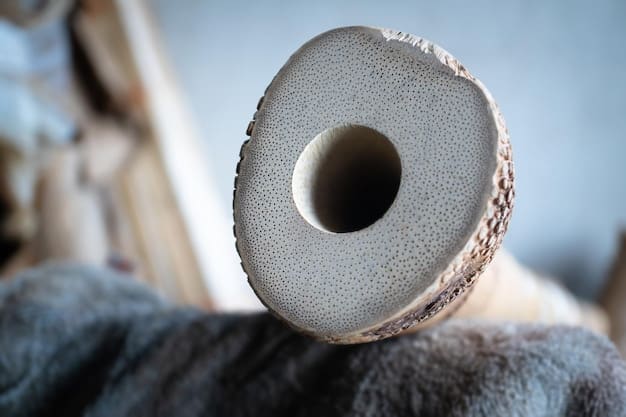Next-Generation Body Armor: New Materials for Soldier Protection by 2026

Next-generation body armor aims to enhance soldier protection by 2026 through the integration of advanced materials like improved ceramics, composite materials and innovative textiles, offering lighter weight, increased ballistic resistance, and enhanced comfort.
The landscape of military technology is constantly evolving, and one of the most critical areas of advancement is in soldier protection. By 2026, next-generation body armor promises to significantly improve the safety and effectiveness of military personnel through the use of cutting-edge materials.
The Evolution of Body Armor Technology
Body armor has undergone a dramatic transformation over the centuries, from simple leather and metal plates to sophisticated composite materials. This evolution reflects the changing nature of warfare and the increasing lethality of weapons. Understanding this history provides context for the next wave of advancements.
Early forms of body armor, such as those used by Roman soldiers, were heavy and cumbersome. The introduction of firearms in the Middle Ages led to the development of plate armor, which offered greater protection but severely restricted mobility. Modern body armor began to take shape in the 20th century, with the invention of ballistic nylon and, later, Kevlar.
Key Milestones in Body Armor Development
Several key innovations have marked significant improvements in body armor technology. These include:
- The Introduction of Ballistic Nylon: Enabled lighter, more flexible protection against shrapnel and low-velocity projectiles.
- The Development of Kevlar: Revolutionized body armor by offering high tensile strength relative to its weight.
- Ceramic Plate Integration: Enhanced protection against rifle rounds and other high-velocity threats.

Today, body armor typically consists of a combination of soft armor panels made from materials like Kevlar or Spectra Shield, and hard armor plates made from ceramics or composite materials. This combination provides a balance of flexibility, comfort, and protection against a wide range of threats. Progressing from these materials, the focus is now on the advancements to be seen by 2026.
Advancements in Materials Science
The quest for better body armor hinges on advances in materials science. New materials are being developed to offer improved ballistic resistance, reduced weight, and enhanced comfort. These advancements are crucial for ensuring that soldiers can operate effectively in diverse and demanding environments.
Researchers are exploring a variety of materials, including advanced ceramics, composite materials, and innovative textiles. These materials are designed to absorb and dissipate energy from projectiles, minimizing the risk of injury. The goal is to create armor that is both lightweight and highly effective.
Emerging Materials for Next-Generation Armor
The future of body armor lies in the development and integration of the following materials:
- Improved Ceramics: Offering higher hardness and fracture toughness for better ballistic performance.
- Composite Materials: Combining different materials to achieve specific properties, such as high strength and low weight.
- Innovative Textiles: Utilizing advanced weaving techniques and fiber technologies to create lighter and more flexible armor.
The integration of these advanced materials promises to provide soldiers with a new level of protection while maintaining or even improving their mobility and comfort.
The Role of Nanotechnology
Nanotechnology is playing an increasingly important role in the development of next-generation body armor. By manipulating materials at the nanoscale, scientists can create structures with exceptional strength, stiffness, and energy absorption capabilities. This opens up new possibilities for designing armor that is both lightweight and highly effective.
One promising application of nanotechnology is the development of nanofiber-reinforced composites. By incorporating nanofibers into a polymer matrix, researchers can create materials with significantly enhanced mechanical properties. These composites can be used to create lighter and stronger armor plates and soft armor panels.
Applications of Nanotechnology in Body Armor
Nanotechnology is being applied in several key areas of body armor development:
- Nanofiber-Reinforced Composites: Enhancing the strength and stiffness of armor materials.
- Self-Healing Materials: Creating armor that can repair itself after being damaged.
- Smart Textiles: Integrating sensors and electronics into armor to monitor soldier health and environmental conditions.

These advancements promise to transform the capabilities of body armor, providing soldiers with a level of protection that was previously unattainable.
Design and Ergonomics
In addition to materials science, design and ergonomics are essential considerations in the development of next-generation body armor. Armor must be not only protective but also comfortable and easy to wear. Poorly designed armor can restrict movement, cause fatigue, and reduce overall effectiveness.
Modern body armor designs emphasize modularity and adjustability. This allows soldiers to customize their armor to suit specific mission requirements and body types. Modular designs also make it easier to integrate new technologies and capabilities as they become available.
Key Design Considerations
Several key design considerations are driving the development of next-generation body armor:
- Modularity: Allowing soldiers to add or remove components as needed.
- Adjustability: Ensuring a comfortable and secure fit for a wide range of body types.
- Integration: Seamlessly incorporating armor with other equipment, such as helmets, communication devices, and load-bearing systems.
By focusing on these design principles, manufacturers can create armor that enhances soldier performance and survivability.
Testing and Validation
Rigorous testing and validation are critical to ensure that next-generation body armor meets the required performance standards. Armor must be subjected to a variety of tests to evaluate its ballistic resistance, durability, and comfort. These tests help identify any weaknesses or limitations of the armor, allowing manufacturers to make necessary improvements.
Ballistic testing typically involves firing projectiles at the armor at various velocities and angles. The armor must be able to stop the projectiles without causing life-threatening injuries to the wearer. Durability testing evaluates the armor’s resistance to wear and tear under operational conditions.
Testing Protocols for Body Armor
Standard testing protocols include:
- Ballistic Testing: Evaluating resistance to projectiles, like bullets and shrapnel.
- Environmental Testing: Assessing performance in extreme temperatures, humidity, and other environmental conditions.
- Durability Testing: Measuring resistance to wear and tear, including abrasion, impact, and chemical exposure.
These stringent testing protocols ensure deployed armor meets the stringent demands expected of them.
Challenges and Future Directions
Despite the significant advances in body armor technology, there are still several challenges to overcome. One of the biggest challenges is balancing protection, weight, and comfort. Armor that is too heavy or uncomfortable can hinder soldier performance and reduce overall effectiveness.
Another challenge is developing armor that can protect against emerging threats, such as advanced armor-piercing rounds and improvised explosive devices (IEDs). This requires ongoing research and development of new materials and designs. The future of body armor will likely involve a combination of incremental improvements and disruptive innovations.
Future Trends in Body Armor
- Integration of Exoskeletons: Reducing the burden of carrying heavy armor and equipment.
- Development of Active Protection Systems: Using sensors and actuators to detect and neutralize threats before they impact the armor.
- Creation of Adaptive Armor: Adjusting its properties in response to changing environmental conditions or threat levels.
Cost and Affordability
The cost of next-generation body armor is a significant concern for military organizations. Advanced materials and manufacturing techniques can be expensive, making it difficult to equip large numbers of soldiers with the latest protection. Efforts are underway to reduce the cost of body armor through the development of more efficient manufacturing processes and the use of less expensive materials.
One approach is to focus on developing armor that can be easily upgraded or repaired. This can extend the lifespan of the armor and reduce the overall cost of ownership. Another approach is to collaborate with commercial companies to leverage their expertise and economies of scale.
| Key Point | Brief Description |
|---|---|
| 🛡️ Advanced Materials | Use of ceramics, composites, and textiles for enhanced protection. |
| 🔬 Nanotechnology | Application of nanofibers for stronger and more durable armor. |
| 📐 Ergonomic Design | Focus on modularity, adjustability, and comfort for better mobility. |
| 🧪 Rigorous Testing | Ensuring armor meets standards through ballistic and environmental tests. |
FAQ
▼
The main objectives include enhancing protection against ballistic threats, reducing weight for increased mobility, and improving comfort to minimize soldier fatigue during operations.
▼
Advanced ceramics, composite materials, and innovative textiles are key components. These materials offer improved strength, reduced weight, and enhanced energy absorption capabilities.
▼
Nanotechnology is being applied to create nanofiber-reinforced composites, self-healing materials, and smart textiles, which enhance the overall strength, durability, and functionality of body armor.
▼
Key considerations include modularity, allowing soldiers to customize their armor; adjustability, ensuring a comfortable fit; and integration with other equipment such as helmets and communication devices.
▼
Testing includes ballistic testing to evaluate resistance to projectiles, environmental testing to assess performance in extreme conditions, and durability testing to measure resistance to normal wear and tear.
Conclusion
The development of next-generation body armor is a complex and ongoing process, requiring collaboration between scientists, engineers, and military personnel. By focusing on advanced materials, innovative designs, and rigorous testing, it is possible to create armor that provides soldiers with the best possible protection while enabling them to operate effectively in any environment. The advancements expected by 2026 promise to significantly enhance soldier survivability and mission success.





